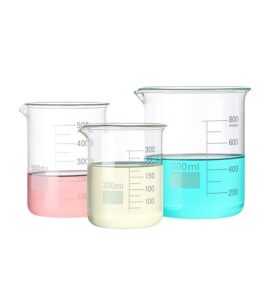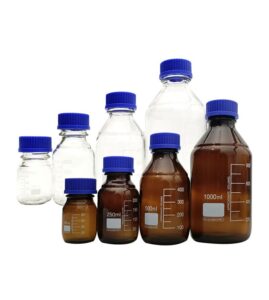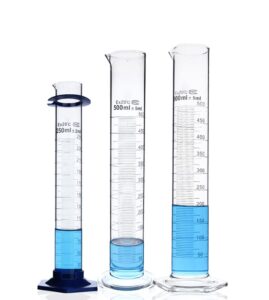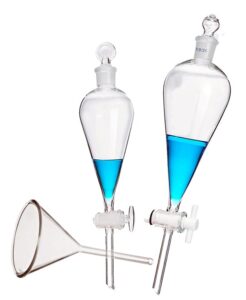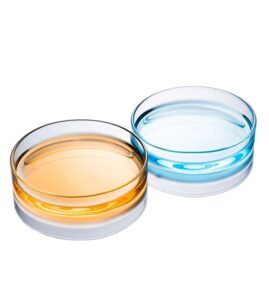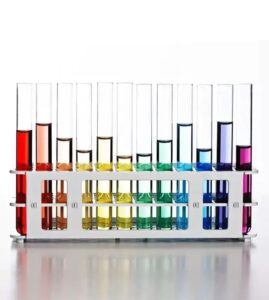In the realm of science, accuracy is paramount. The simplest of tools, such as a measuring cylinder, can sometimes be the most vital. But, have you ever considered the correct way to use a measuring cylinder? Or the subtleties that can influence the accuracy of your measurements?
Understanding how to use a measuring cylinder correctly can significantly improve the precision of your experiments. Whether you’re in a school laboratory, a professional research lab, or even your home kitchen, mastering this tool is essential.
The Basics of Using a Measuring Cylinder
Using a measuring cylinder begins with understanding the unit’s graduations. Each cylinder comes with a series of lines known as graduations, denoting different volumes. Understanding how to read these graduations is essential for accurate measurements.
To measure a liquid using a measuring cylinder, fill it up to the required level by observing the lowest point of the meniscus (the curve formed by the liquid at the surface). It’s crucial to read this value at eye level, directly in line with the meniscus, to prevent parallax error.
When measuring certain liquids, particularly those that are viscous or prone to foam, a few additional steps may be necessary to obtain an accurate reading.
Understanding the Meniscus
The meniscus is the curved surface of a liquid in a narrow cylindrical container. It can curve upwards (forming a “U” shape) or downwards (forming a “n” shape), depending on the liquid’s properties. For most liquids, including water and aqueous solutions, the meniscus is concave, meaning it curves upward.
When using a measuring cylinder, it is vital to always read the bottom of the meniscus when measuring the liquid volume. This technique ensures the most accurate measurement, minimizing the potential for reading errors.
Step-By-Step Guide to Using a Measuring Cylinder
Below is a straightforward, step-by-step guide to help you master the use of a measuring cylinder. By following these simple steps, you’ll be able to use a measuring cylinder with accuracy and ease.
Step 1: Choosing the Right Cylinder
Measuring cylinders come in various sizes, from 10 mL to 1000 mL or even larger. The choice of the cylinder should depend on the volume of the liquid you intend to measure. Ideally, choose a cylinder in which the volume to be measured takes up at least 40% of its total capacity.
Step 2: Cleanliness Check
Ensure your measuring cylinder is clean and dry before using it. Leftover residue can affect the accuracy of your measurements. Use a lab-grade detergent to clean the cylinder, then rinse thoroughly with tap water, followed by distilled water.
Step 3: Positioning the Cylinder
Place the measuring cylinder on a flat, stable surface to ensure it stands straight. This step is crucial as a tilted cylinder could lead to inaccurate readings.
Step 4: Pouring the Liquid
Pour the liquid into the measuring cylinder slowly to avoid splashes and excessive formation of the meniscus. It’s preferable to use a funnel for liquids that could spill or splash easily.
Step 5: Reading the Measurement
Bend down or lift the cylinder up so that your eye is level with the meniscus (the curved upper surface of the liquid). The correct reading is at the bottom of the meniscus. Make sure your eye is vertically above this point to avoid parallax error.
Step 6: Recording the Measurement
Record your measurement as accurately as possible. For instance, if the markings on your measuring cylinder are in 1 mL increments and the bottom of the meniscus is between two markings, you might estimate the volume to the nearest 0.5 mL.
Step 7: Cleaning After Use
Always clean the measuring cylinder after use. Rinse it with water to remove any leftover liquid and then clean it with a lab-grade detergent. Rinse it again with water, and finally with distilled or deionized water. Dry it thoroughly before storing or using again.
Ensuring Precision in Every Measurement
Achieving precision with a measuring cylinder depends on not just understanding the steps involved but also executing them meticulously. Let’s address some key considerations to ensure the highest precision:
Temperature Considerations: Remember that the calibration of most measuring cylinders is at a specific temperature, typically 20°C. Changes in temperature can cause the glass to expand or contract, which might affect the accuracy of your measurements.
Dealing with Parallax Error: Ensure that you are reading the meniscus at eye level. Any deviation can result in a parallax error, which can affect the accuracy of your measurement.
Avoiding the Wetting Effect: Some liquids, especially viscous ones, tend to stick to the walls of the cylinder. This wetting effect can lead to inaccurate volume readings. To mitigate this, allow the liquid to settle and use a cylinder made from a material suitable for the specific liquid.
Repeated Measurements: For enhanced accuracy, it’s advisable to make repeated measurements and calculate the average. This approach can help offset any minor errors that might occur in a single measurement.
The Different Types of Measuring Cylinders: Which One Do You Need?
Understanding the different types of measuring cylinders can also assist you in selecting the most suitable one for your measurement needs.
Single Metric Scale Graduated Cylinders: These cylinders have one metric scale and are calibrated either “to contain” (TC) or “to deliver” (TD) a specific volume.
Double Metric Scale Graduated Cylinders: These cylinders have two metric scales, useful for taking measurements from different reference points.
Class A and Class B Cylinders: Class A cylinders offer the highest precision, ideal for professional labs, whereas Class B cylinders provide lesser precision but are more cost-effective, making them appropriate for educational settings or less critical measurements.
Polypropylene Cylinders: These cylinders, made of plastic, offer high durability and excellent chemical resistance. They are autoclavable, making them suitable for biological labs.
Borosilicate Glass Cylinders: These cylinders provide excellent thermal resistance and high chemical resistance, perfect for use with hot liquids or corrosive chemicals.
Tips for Precise Measurements
Getting precise measurements from a measuring cylinder involves several crucial steps. Here are some tips for ensuring accurate measurements:
Use the Right Cylinder Size: If you’re measuring a small volume, use a smaller cylinder. Using a large cylinder to measure small volumes can lead to errors due to the lower precision of the graduations.
Clean the Cylinder: Always ensure the cylinder is clean before use. Leftover substances can affect the volume reading and potentially react with the substance you’re measuring.
Avoid Pouring Excess Liquid: If you pour more liquid than needed, do not pour it back into the container, as it may be contaminated. Instead, dispose of it properly.
Handle with Care: Handle the measuring cylinder carefully. They can easily tip over, leading to spillage and potentially inaccurate measurements.
Additional Considerations for Viscous Liquids
Viscous liquids such as glycerol or concentrated solutions of certain sugars and proteins behave slightly differently than less viscous liquids like water. These liquids may take longer to settle, and their meniscus may be harder to read.
In addition, they may coat the walls of the measuring cylinder, leading to an overestimate of the volume. This effect is known as the “wetting effect”. To mitigate this issue, allow the liquid to settle and avoid shaking or moving the cylinder once the liquid has been added.
Frequently Asked Questions
Here are answers to some commonly asked questions about how to use
a measuring cylinder:
How do I ensure the highest precision when using a measuring cylinder?
The key to achieving high precision with a measuring cylinder is attention to detail. Always clean the cylinder before use, choose the appropriate size for the volume you’re measuring, read the bottom of the meniscus at eye level, and handle the cylinder with care to avoid spillage.
How do I measure the volume of a solid with a measuring cylinder?
You can measure the volume of a solid using a method called water displacement. Fill the measuring cylinder with a known volume of water, then carefully add the solid. The increase in the water’s volume is equivalent to the volume of the solid.
Can I use a measuring cylinder to measure the volume of a gas?
In general, measuring cylinders are not suitable for measuring gas volume because gases can easily escape from the open top of the cylinder. Specialized gas syringes or gas collection tubes are typically used for this purpose.
Maintaining and Storing Measuring Cylinders
Maintaining your measuring cylinders is crucial for their longevity and accuracy. Always clean your cylinders after use. Use a suitable lab-grade detergent, rinse with tap water, then rinse again with distilled or deionized water. Make sure to store them in a clean, dry place.
Remember, a measuring cylinder is made of glass, so handle with care to avoid cracks or chips that could affect measurement accuracy or cause the cylinder to break when filled with a liquid.
Embracing the Art of Accurate Measurement
Mastering the use of a measuring cylinder is a vital skill in laboratory science. It allows for precise volume measurements, ensuring accuracy in experiments and processes. A keen understanding of the measuring cylinder, coupled with careful technique, can lead to optimal results in the lab.
Concluding Thoughts
Precision and accuracy are the pillars of any scientific endeavor. The humble measuring cylinder, although simple in design, plays a pivotal role in achieving this precision. Understanding how to use it correctly and mindfully can dramatically enhance the accuracy of your measurements, be it in a laboratory, a classroom, or a home kitchen.
Next time you hold a measuring cylinder, remember the simple steps outlined in this article. With a clear understanding and mindful practice, you will find yourself mastering the art of accurate measurement.
In essence, the correct use of a measuring cylinder goes beyond just reading the bottom of the meniscus. It is about choosing the right cylinder, maintaining it well, and being mindful of various factors that can influence the accuracy of the measurement. As we conclude this guide, we hope you’re better equipped to use this essential tool with enhanced precision and confidence.


